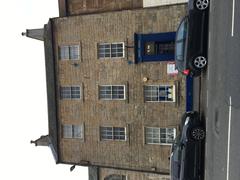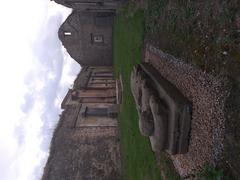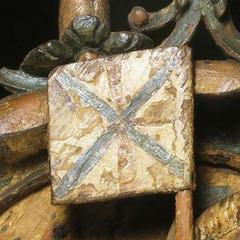Whitburn Manse Road War Memorial: Visiting Hours, Tickets, and Historical Significance in Livingston, United Kingdom
Date: 14/06/2025
Introduction: History and Importance
The Whitburn Manse Road War Memorial, set in the heart of Whitburn, West Lothian, stands as an enduring tribute to the local men and women who made the ultimate sacrifice from the First World War through to modern conflicts. Unveiled in 1921, the memorial is a cornerstone of Scotland’s heritage and a focal point for remembrance, symbolizing the collective memory and resilience of the Whitburn community (War Memorials Trust).
With its classical design—a bronze soldier atop a stepped granite base—the memorial commemorates 24 individuals from WWI, 28 from WWII, and others from the Korean War, Iraq War, and Northern Ireland conflict. This layered tribute reflects the deep-rooted history of military service in the area (War Memorials Online).
Maintained through conservation efforts and community involvement, the site is accessible year-round during daylight hours. Its interpretive signage and proximity to other West Lothian historical landmarks, such as Linlithgow Palace and Bathgate Processional Way, enhance its role as a living heritage site (Historic Environment Scotland, VisitScotland).
This guide offers detailed insights into the memorial’s history, symbolism, visitor information, access, nearby attractions, and planning tips for a meaningful visit to one of West Lothian’s most significant sites.
Guide Contents
- Origins and Construction
- Commemorated Conflicts
- Symbolism and Design
- Community & Historical Context
- Conservation & Restoration
- Visitor Information (Hours, Tickets, Accessibility, Directions)
- Nearby Attractions
- Special Events & FAQs
- Visiting Etiquette & Local Facilities
- Practical Travel Tips
- Conclusion & Resources
Origins and Construction
Prominently located outside the Community Education Centre on Manse Road, the Whitburn War Memorial was unveiled on 16 October 1921 by General Sir Francis Davies. Its creation was part of a nationwide effort to commemorate the unprecedented sacrifices of World War I (War Memorials Trust). The memorial features a three-stepped granite base topped by a bronze standing soldier, hands on a reversed rifle and head bowed, evoking both mourning and pride (War Memorials Online).
Commemorated Conflicts and Names
Originally dedicated to those who fell in World War I (1914–1919), the memorial’s inscription reads:
“1914 1919
To the glory of God
and in memory of the men
from Whitburn and district
who fell in the Great War
(names)
‘Their name liveth for evermore’”
(War Memorials Trust)
Additional plaques were later added for WWII (1939–1945), the Korean War (1952), Iraq War (2004), and the Northern Ireland conflict. The names of 24 from WWI, 28 from WWII, and others from subsequent conflicts are engraved, underscoring the ongoing impact of military service (Traces of War).
Symbolism and Artistic Features
The reversed rifle of the soldier represents mourning. The stepped base elevates the figure, signifying reverence. Inscriptions such as “Their name liveth for evermore” and plaques listing names ensure collective and individual remembrance (War Memorials Trust). The style is characteristic of post-WWI memorials, with durable materials chosen for longevity.
Community and Historical Context
The memorial’s erection was part of a UK-wide movement responding to the immense losses of WWI (Historic England). Whitburn, with its mining heritage, contributed significantly; over 1,400 men enlisted during WWI. Following the closure of Marsden colliery and the village’s demolition in 1968, a commemorative tablet honoring Marsden servicemen was added, reinforcing the site’s importance (Historic England).
Conservation and Restoration
In 2012, the War Memorials Trust granted £7,238 for essential repairs: repointing frost-damaged joints, cleaning, restoring painted lettering, and remodelling missing details (War Memorials Trust). Ongoing community involvement ensures dignified preservation for future generations.
Visitor Information
Visiting Hours:
Open daily during daylight (approx. 8:00 AM–dusk). No formal hours.
Entry & Tickets:
Free public access. No ticket required.
Accessibility:
Wheelchair accessible with level paved paths. Disabled parking nearby.
Getting There:
- By car: Via A705/A89 roads.
- By public transport: Local buses connect Whitburn to Bathgate and Livingston. Nearest train stations: Bathgate and Livingston North.
Nearby Attractions:
- Linlithgow Palace
- Bathgate Processional Way
- Howden Park Centre
- Community Education Centre (local events)
Guided Tours & Events:
No regular tours, but local heritage groups may host walks or talks near Remembrance and Armistice days. Check local listings or inquire at the Community Education Centre.
Architectural Features and Symbolism
The memorial’s granite construction ensures durability, while its obelisk form and bronze sculpture signify endurance and remembrance (Historic Environment Scotland). Inscriptions are deeply incised, arranged alphabetically to emphasize equality in sacrifice.
- Obelisk: Symbolizes aspiration for peace and enduring memory (Imperial War Museums).
- Wreaths: Represent honor and eternity.
- Christian Motifs: Provide solace and reflect the era’s sentiments.
Role in the Community
The memorial is central to annual Remembrance Sunday ceremonies, with wreath-laying, prayers, and readings of names. It is also a daily site for individual reflection and remembrance.
Safety, Etiquette, and Facilities
- Maintain respectful behavior, particularly during ceremonies.
- Photography is permitted but should not disrupt commemorations.
- Place flowers or poppies as a gesture of respect.
- Local amenities (cafés, shops, restrooms) are within walking distance.
Preservation and Community Involvement
The West Lothian Council manages regular inspections, maintenance, and stabilization of memorials (West Lothian Council). Community groups, schools, and veterans’ organizations participate in cleaning and wreath-laying, fostering shared responsibility.
Genealogical and Historical Research
Names inscribed on the memorial offer a starting point for family history research. West Lothian Council provides assistance with burial records (West Lothian Council).
FAQs
Q: What are the visiting hours?
A: Open daily, dawn to dusk.
Q: Is there an entry fee?
A: No, access is free.
Q: Is the site accessible?
A: Yes, it is wheelchair accessible.
Q: Are guided tours available?
A: No regular tours, but events may be held around commemorative dates.
Q: What other sites are nearby?
A: Linlithgow Palace, Bathgate Hills, Livingston Designer Outlet.
Discovering Whitburn and Livingston: Attractions and Tips
Whitburn and Livingston offer a wealth of historical, cultural, and family-friendly attractions.
- Whitburn: Rich mining heritage, Xcite Whitburn leisure centre, The Hive Soft Play, and close proximity to the Scottish Owl Centre (Day Out With The Kids).
- Livingston: Designer Outlet, Almond Valley Heritage Centre, and Paradise Island Adventure Golf (Livingstoni Tourist Attractions).
- Scottish Korean War Memorial: Arboretum of 1,114 Scottish trees and Korean firs; open daily, free admission (Visit West Lothian).
Travel Tips:
- Public transport is frequent for both towns; car hire is recommended for rural sites.
- Most attractions are wheelchair accessible.
- Visit during commemorative events for a deeper experience.
Planning Your Visit
- Dress for the weather—Scottish conditions can be unpredictable.
- Check local event listings for commemorative ceremonies and community events.
- Respect memorial guidelines—help preserve the dignity of the site.
- Combine your visit with nearby attractions for a richer experience.
Useful Links
- War Memorials Trust
- War Memorials Online
- Historic Environment Scotland
- VisitScotland - Whitburn
- Visit West Lothian - Scottish Korean War Memorial
- West Lothian Council
- Roll of Honour - West Lothian
- Day Out With The Kids - Whitburn
- Livingstoni Tourist Attractions
- Imperial War Museums
- Traces of War - Whitburn
- Historic England
Conclusion
The Whitburn Manse Road War Memorial is not only a solemn monument but a vibrant community landmark, symbolizing the sacrifices of Whitburn’s men and women across generations. With accessible visiting hours, no entry fee, and a central location near other key attractions, the memorial is an essential stop for anyone exploring West Lothian’s historical and cultural landscape.
For updates, immersive tours, and event information, download the Audiala app and follow our social media channels. Enrich your visit by exploring related articles and discovering more about Scotland’s enduring heritage.


